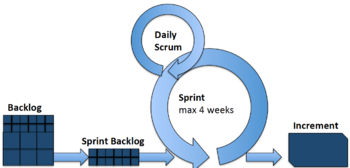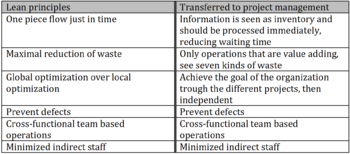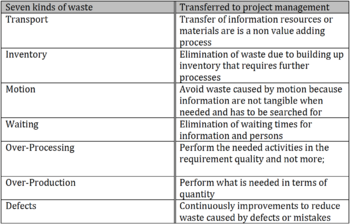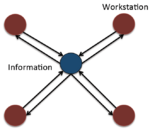The agile framework Scrum in the context of lean project management
Developed by Kai-Sören Sokolowski
Scrum is an agile framework, to execute product development or projects in an iterative, incremental way. [1] [2]Today's organizations are operating in a highly competitive and challenging market that continuously changes and require the organizations to adapt and stay flexible. Scrum, as an agile method, allows organizations to do so and is especially successful in this unique field. [3] These characteristics are what make Scrum to the most widely used agile framework. [1] Furthermore, Scrum is deeply connected with the agile methodology, which is summarized in the "Agile Manifesto" (2001). [4]
This article describes the Scrum framework in reference to the agile methodology. Additionally it provides an insight how Scrum is used in organizations today and finally it puts the Scrum framework in the context of lean project management. To do so the lean principles of projects management will be outlined and reflected on Scrum.
Contents |
Scrum

Scrum methodology is based on empirical process control theory. Empiricism, and so Scrum, assumes that knowledge is gained from experience and that decision-making is based on known knowledge. Therefore, Scrum is a circular and incremental methodology following the goal to optimize planing capability and controlling risk (see fig. 1). [2] Scrum is performed by cross-functional teams, which work in cycles of work - Sprints.[2] [1] These cross-functional teams have to perform different Scrum Roles, Scrum Events and Scrum Artifacts to follow the Scrum framework.[1] [2]
In relation to this, Scrum is based on the same three pillars as the empirical process control[2]:
1) Transparency: Process and obstacles during the project execution are made visible and get documented
2) Inspection: In regular intervals product-functions are delivered and the product as the process gets evaluated
3) Adaption: Specifications of the product, the plan and the process are not determined, but continuously adapted
Scrum is therefore not reducing the complexity of a project, but is structuring the project in smaller and less complex increments.
Scrum Roles
The cross-functional Scrum Teams work self organized and can choose the way to accomplish the work by their own. The functional setup of the team has to make dependencies to other functions outside the team unnecessary. Only those teams are able to offer the maximal flexibility, creativity and at the end productivity. Even though the Scrum Teams are free in their working approaches, three Scrum Roles exist and are imperative to perform. [2] In contrast to traditional project management approaches, the role of a Project Manager does not exist. The more traditional tasks of a Project Manager are split up and assigned to the three Scrum Roles, where the most management related tasks can be find in the Scrum Roles of the Product Owner and the Development Team.
The Product Owner is the last decision maker in concerns of the project execution, and it is therefore he or she who is responsible in terms of value / return of investment (ROI) maximization of the project. This also includes to maximize the value of the Development Team's work. The Product Owner is not working alone, but it is, however, the Product Owner alone who is responsible for the value of the project. [1] [2] Even though the Product Owner seems to represent the opinions of a committee, he or she has the final say. The main task of the Product Owner is to manage the general Backlog. This can be done actively by the Product Owner or passively as the Product Owner manages the Development Team to do so. No matter how the Backlog is managed it is the Product Owner who stays responsible. It is also the Product Owner, who should optimize and push the Development Team’s performance. [5]
The Development Team executes the project that the Scrum Team outlines. This Team is self-organized and consists of cross-functional professionals, which offer all needed expertise to deliver the next Sprint Goal. The Development Team is empowered to work autonomously. There are no sub teams existing in the Development Team as well as no title for the Team members; all members are referred to as "Developers". As we talk about cross-functional teams, team members have primary, secondary and even more skills, but will help wherever there is work to be done. This creates a multi learning effect in the teams. In the optimal case the Scrum Team is small enough to stay flexible and big enough to contain all necessary skills to complete the Sprint Goal.[1]
The Scrum Master is a service provider for the different Scrum roles and for parties outside the Scrum Teams. The Scrum Master offers different services to the different parties. One service the Scrum Master never offers is the active or passive project management. The Scrum Master's duty is to achieve a good understanding of Scrum within the Scrum Team and the organization. It is the Scrum Master's responsibility that all Scrum Events are attended by the necessary persons and hold efficiently. This had to be done even though the Scrum Master is not actively moderating and sometimes not even participating in the event. [5]
Scrum Values
Due to the fact that Scrum is an empirical approach, where self-organized teams are working towards the same goal, different values have to be shared within the Scrum Team to make Scrum work efficiently. In "The Scrum Guide" Schwaber and Sutherland outline the following values as being necessary values for every Scrum Team member to have [2]:
- Commitment – personal commitment of the team member to achieve the goals
- Courage – the team member has to have the courage to do the right tasks and to work on problems
- Focus – everybody has to focus on the Sprint and the Goals
- Openness – in reference to work and performance challenges of work
- Respect – Scrum Team members respect each other as capable independent persons
According to Schwaber and Sutherland it is only if these values are shared, that an atmosphere that activates the three pillars of transparency, inspection and adaption, is possible within the Scrum Team. These three pillars are necessary for successful Scrum project management, which is why the shared values are so important. In addition to this, it is essential that the definition of "done", when an increment is completed is understood and lived by the whole Scrum Team. Only if everybody has the same understanding of "done" the Scrum framework can be executed efficiently and without any conflicts. [2]
Scrum Events
Scrum is based on repeating events, which create regularity and agility in the work process. These events also minimize the need for extraordinary meetings, which are not defined in Scrum.
The Sprint is the core event of Scrum. A Sprint is maximum a four weeks long period, where an increment of the project is created. Sprints are ending on a set date, and they cannot be extended, even though the increment, often also referred as "done " is not achieved. Sprints are taking place in an iterative, cyclic way where one Sprint is followed directly by a new Sprint. During the Sprint following Scrum Events are performed: Sprint Planning, Daily Scrums, Development Work, Sprint Review and Sprint Retrospective. Sprints can be considered as independent projects with a maximum duration of four weeks where, as typical for projects, something has to be created. Since the stated goal cannot be changed during the Sprint, it is important to define, what should be achieved during the Sprint before each Sprint. [1]
Only the Product Owner can cancel a Sprint before it is over. A Sprint can only be canceled under the circumstance that the Sprint Goal gets outdated. A goal can be outdated due to the organization changing its strategy or unexpected market or technology changes occur. Even if a Sprint is canceled, the temporary achievements get reviewed and all incomplete content of the Backlog gets re-estimated.[5]
The Scrum Event Sprint Planning is about figuring out and outlining what work has to be achieved during the Sprint. The whole Scrum Team is attending the Event to outline the plan. Event Sprint Planning has a time frame that can vary, but is capped to maximum eight hours for a four weeks Sprint. For shorter Sprints, the Sprint Planning phase is normally shorter. During the Sprint Planning two major concerns has to be answered:
1) What should and can be done in the Sprint?
2) How can it be achieved?
The major input for the Sprint Planning is the Backlog, the latest achievements, increments, and performance of the Development Team. During the Sprint Planning event the requirements of the Backlog, chosen by the Development Team, is discussed with the Product Owner. This is done in order to define the Sprint Backlog. The last step of the Sprint Planning is to design a Sprint Goal, which is an objective that will guide the work during the Sprint. Furthermore, the Development Team has to decide how the increment should be achieved and this process is to be documented in the Sprint Backlog. In case the Development Team finds that the chosen content of the Backlog requires too much or to less work it can renegotiate the selected content of the Backlog with the Product Owner. Before the Development Team starts working it has to reasonably explain the Product Owner and Scrum Master how it will achieve the Sprint Goal.[2]
The Daily Scrum is an iterative 15 minutes long Scrum Event that, as the name implies, takes place every day at the same time and place. The Daily Scrum is designed to give the Development Team a chance to synchronize activities and outline a plan for the next 24 hours. The plan is created by reviewing the work that has been done since the last Daily Scrum and by forecasting what will happen until the next Daily Scrum. Completing the Sprint Backlog is an inspection progress towards the Sprint Goal, while the Daily Scrum raises the probability that the Development Team stays on track and meets the Sprint Goals. Efficiently conducted Daily Scrum makes other meetings reluctant, identifies obstacles, contributes to quick decision-making, and raises the Development Team’s knowledge level. The Daily Scrum is the key meeting during the Sprint for inspection and adaption.[1]
At the end of a Sprint, the Sprint Review, which is an informal meeting, takes place. The Sprint Review is maximum four hours long for a four week Sprint and is attended by the Scrum Team and stakeholders. The Sprint Review is used to inspect the increment of the Sprint and discuss the achievements of the Sprint with all relevant persons. The outcome of the Sprint Review is a revised Backlog, and if needed, an adjusted overall Backlog to reach for new opportunities can be made.[1]
The last event is the Sprint Retrospective. The Sprint Retrospective is limited to a maximum of three hours and is used for the Scrum Team to inspect itself and improve its working procedures during the Sprints. Even tough improvements may be made during the Sprint, the Sprint Retrospective is the formal event that is used to focus on inspection and improvement of the working processes. [5]
Scrum Artifacts
Scrum Artifacts are documents, or achieved increments, which represent work or value. Scrum Artifacts are designed to have maximum transparency of information in order to make them understandable for everybody. In addition to this, transparency provides the best base to see opportunities and do inspections and adaptions.[5]
The general Backlog is the main document for the project and is normally an ordered list of everything that may be necessary in order to execute the project. It is also the only source for making changes to the set of requirements for the project. The Backlog is a dynamic document, which is never complete, and is used to identify constant changes in order to execute the project appropriate and useful. In the first part, the Backlog outlines the initially known and registered requirements of the project. The Backlog grows as the project and environment evolve. The Backlog monitors the progress in order to achieve the overall goals and shows the remaining work at anytime. The remaining tasks are related to when the project should be conducted. Here different forecast methods have been proven as useful, e.g. cumulative flows.[5]
The Sprint Backlog contains selected content of the general Backlog that has to be achieved during the Sprint. Additionally, it contains a plan of how the achieve the Increment and the Sprint Goal. The Sprint Backlog is a real-time document of the work status in the Sprint and belongs to the Development Team. It is also the basis for the Daily Scrum events, and as the general Backlog, the Sprint Backlog changes and emerges during the Sprint. It is monitoring the Sprint progress towards the Sprint Goal.[5]
The Increment is the sum of all achieved requirements, items, and content that has been achieved from the general Backlog in the previous Sprints. [5]
Scrum's Advantages and Limitations
As mentioned above, Scrum offers different advantages in comparison to traditional project management approaches. The most obvious is the agility of Scrum that adopts feedback from stakeholders and costumers. Especially short Sprints enable Scrum to react fast on changing demands and feedback of different groups. Additionally, Scrum allows to divide large and complex projects in smaller pieces (Sprints) to increase the manageability. With it Scrum ensures an effective management of resources and money as well as the direct test and reviewing of the achieved content through the Scrum reviews. For the employees involved in a Scrum managed project, the Scrum framework offers a clear visibility of the Goal through the Scrum meetings and the Daily Scrum illustrates the individual contribution to the project.[6]
As any other approach, Scrum also has its limitations and disadvantages. One limitations is that it is difficult and challenging to introduce the Scrum framework to large project teams and that the success of Scrum is heavily depending on the commitment and cooperation of the team members. Moreover, the Scrum framework is only successful if experienced team members (in Scrum) are existing. If the end date for the Scrum project is missing it often leads to a slow process. For the Scrum Team Members the daily meetings sometimes can be frustrating, and leaving Scrum Team Members have a huge impact on the whole project.[6]
Lean Project Management




Since the 1990's lean principles has been included in general management practices. At the same time many lean approaches have been infiltrating the project-based industries – and are still part of them today. It is visible how operations have improved through lean principles in project management and studies have shown that lean producers are also superior in context of project performance. However, there is no research that proves that lean principles in the context of project management are as superior as in the automotive industry. [7] As the lean principles originally are production related, they need to be transferred into the context of project management. This transfer can be seen in Table 1, which illustrates that in context of lean project management the elimination of waste is the most credential. Waste caused by doubled information, stored but not processes information, caused by making mistakes without detect, and other not value adding processes should be reduced. To do so lean project management sets on transparency and multi skilled teams.[7] In addition to transparency, lean project management focuses on direct flow – and preferable one-piece flow. In the context of communication, the flow has to be simplified in order to avoid complexity and with that, the risk of unprocessed information. A transparent and direct information flow leads to direct processing of information and minimizes handover times. Another positive factor due to transparency, is that the different stakeholders cannot hide behind unprocessed information. The Figures 2 and 3 illustrate the transformation of the communication flow. The major aspect of lean is the ideology to eliminate waste, where everything that is not adding value is defined as waste. Table 2 shows the transfer of the outlined seven kinds of waste of the Lean Thinking in its origin as well as transferred in the project management context. It shows that some lean principles do not have to be converted because they are one to one usable in project management, while other principles have to be transferred to the new context. One example is the flow of inventory and pieces through a production system to be understood as flow of information through a project.[7] In the lean project management theory there do exist some basic rules that should be applied in the overall project organization. As lean project management often searched for high technology solutions these applications are more related to common sense. Studies have proven that up to 90 percent of all improvements are created through common sense. The rules are[7]:
1) Simplification - structures and processes can be unnecessary complicated and this can create too much room for interpretation
2) Task Combination - combine tasks through cross-functional teams is eliminating transfer time and the amount of handovers of information
3) Reduce Waste - everything not value adding should be eliminated e.g. bureaucracy.
Scrum in the Context of Lean Project Management
This part will investigate to which extend the agile framework, Scrum, shows convergence with lean Management. Therefore Scrum, with its defined structures and processes, is consequently compared with the lean project management approach. The comparison will start by outlining the general basic rules of the lean project management approach and will slowly go more in depth. The comparison of Scrum and the basic disciplines of lean project management are showing a high level of compliance. In relation to the first rule, simplification, Scrum is a well-structured approach with clear defined events and working phases. Scrum therefore is not based on maximal simplification, but on transparency. In this process it is the Scrum Master's task to educate the Scrum Team. The second rule, task combination, can be seen as fulfilled by Scrum. Due to the fact that the second rule states to combine tasks through working in cross-functional teams Scrum is completely convergent in this point. In relation to the third rule, which is waste reduction, Scrum itself do not have waste reduction as goal, however, Scrum is indirectly having waste reduction through its structure. Through the maximum duration of the sprints the amount of producible waste is capped. In addition to this, Scrum is an empirical approach based on inspection and adaption, this means learning from knowledge. Transferred to the lean project management, this is the same as the mission to avoid defects and mistakes.
As Scrum is convergent with the basic rules of lean project management, the communication, and especially the transfer of information, will be investigated. The lean project management is having a transparent simplified direct information flow as a necessity. However, Scrum is showing the transparency different (see fig. 4). The lean principle is passing the information through the system with the goal to get them fast out of the system. The Scrum approach is different in the way that this approach, trough its structures and Artifacts of the Backlog and the Sprint Backlog, is using an information flow, which is centered on these Backlogs. The Backlogs are functioning as information hubs. As the Sprint Backlog is a real time document and the general Backlog is re-organized after each Sprint it is a way of direct information processing. All team members are getting their information from the Backlog. The Backlog is therefore also minimizing the amount of information that is being handed over.
The last step is to discuss how Scrum is in line with the lean project management on the level of singled principles. As shown in Table 1 most things are already covered through the discussion above. Further open points to discuss from Table 1 are, global optimization over local optimization and minimization of indirect staff. Global optimization over local optimization is one core concept of agile approaches such as Scrum. These agile core concepts are summed in "The Agile Manifesto"[4]: Individuals and interactions over processes and tools; Working software over comprehensive documentation; Customer collaboration over contract negotiation; Responding to change over following a plan. The idea of Scrum is based on market contact and being able to react on changing markets and strategies. Minimization of indirect staff can be found fractionally in Scrum, in the way that Scrum is not actively minimizing indirect staff but also does not require indirect staff through its organization. All Scrum roles have to be filled and the Development Team should be as small as possible, but still filled with all necessary resources. It is more the organizational structure around the Scrum team that defines the amount of indirect staff.
Future Research
As scrum is the most widely used agile framework for project management, it is surprising that there is no more detailed research in context of dependencies of Scrum and lean project management. Even though the approaches have different origin, they have high convergence in their basis and basic disciplines. The dependencies are opening an interesting research field. Especially due to that fact that due to basis missing research, many organizations will not find Scrum as a method to install lean project management. In contrast, the comparison has show, that Scrum can be a valuable framework, not only to be agile, but also to install a lean project management approach. Some possible research areas are:
- Scrum as tool for lean project management. Can Scrum be used together with other project management approaches to implement a lean project management?
- Scrum and lean project management - synergy effects or contra productive?
- Can Scrum replace traditional project management for planned ahead projects to slim the processes?
References
- ↑ 1.0 1.1 1.2 1.3 1.4 1.5 1.6 1.7 1.8 1.9 Pete Deemer; Gabrielle Benefield; Craig Larman; Bas Vodde (December 17, 2012). "The Scrum Primer: A Lightweight Guide to the Theory and Practice of Scrum (Version 2.0)." Annotated: A guide for the Scrum framework. In contrast to the "The Scrum Guide" it is focusing more explicit on the dependencies between the different aspects within Scrum framework.
- ↑ 2.00 2.01 2.02 2.03 2.04 2.05 2.06 2.07 2.08 2.09 2.10 Ken Schwaber and Jeff Sutherland: The Scrum Guide. Abgerufen am 23. März 2014. Annotated: Short and precise guide that explains the Scrum framework in form of a catalogue.
- ↑ 3.0 3.1 "The State of Scrum: Benchmarks and Guidelines. How the world successfully applying the most popular Agile approach to projects." ScrumAlliance. 2013 Annotated: Status report of the usage of Scrum in different industry sectors.
- ↑ 4.0 4.1 Agilemanifesto.org. (2016). Manifesto for Agile Software Development. [online] Available at: http://agilemanifesto.org [Accessed 26 Sep. 2016]. Annotated: The Agile Manifesto states the twelve core practices of agile development and is signed by renowned scholars and practitioners of agile development.
- ↑ 5.0 5.1 5.2 5.3 5.4 5.5 5.6 5.7 5.8 What is Scrum? An Agile Framework for Completing Complex Projects - Scrum Alliance. Scrum Alliance. Retrieved 24 February 2016. Annotated: Report that explains the Scrum framework in context to reduce complexity and uncertainty of projects.
- ↑ 6.0 6.1 Simplilearn.com. (2016). Scrum Project Management Pros and Cons | CSM Training. [online] Available at: http://www.simplilearn.com/scrum-project-management-article [Accessed 26 Sep. 2016]. Annotated: A short and precise summary of advantages and disadvantages of Scrum from the perspective of the organization and the employees
- ↑ 7.0 7.1 7.2 7.3 7.4 7.5 7.6 7.7 Maylor, H. (2010). Project management. Harlow, England: Financial Times Prentice Hall. Annotated: This book sums up the newest practices of project management used by best-practice companies to improve the overall project management performance.
